Related Research Articles
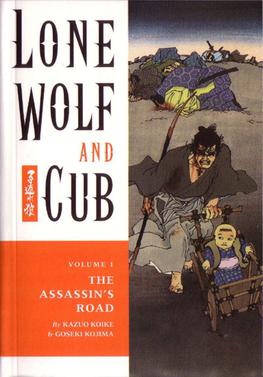
Lone Wolf and Cub is a Japanese manga series created by writer Kazuo Koike and artist Goseki Kojima. First published in 1970, the story was adapted into six films starring Tomisaburo Wakayama, four plays, and a television series starring Kinnosuke Yorozuya, and is widely recognized as an important and influential work.

Shogun Assassin is a 1980 jidaigeki film directed by Robert Houston.
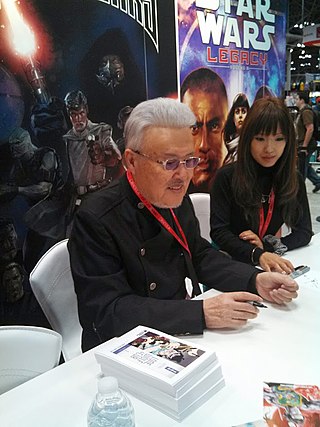
Kazuo Koike was a prolific Japanese manga writer (gensakusha), novelist, screenwriter, lyricist and entrepreneur. He is best known for his violent, artful seinen manga, notably Lone Wolf and Cub, Lady Snowblood and Crying Freeman, which – along with their numerous media adaptations − have been credited for their influence on the international growth of Japanese popular culture.
Goseki Kojima was a Japanese manga artist. He is known for his collaborations with manga writer Kazuo Koike, the most famous of them being Lone Wolf and Cub.

Tomisaburō Wakayama, born Masaru Okumura, was a Japanese actor best known for playing Ogami Ittō, the scowling ronin warrior in the six Lone Wolf and Cub samurai films.

Samurai Executioner, known in Japan as Kubikiri Asa (首斬り朝), is a 10-volume manga created by writer Kazuo Koike and artist Goseki Kojima, the same team that created the popular Lone Wolf and Cub series. The series was first serialized in Japan, from 1972–1976. Samurai Executioner is set earlier than Lone Wolf and Cub, with the main character of the former series appearing in a chapter of the latter.

Masakazu Tamura was a Japanese film and theatre actor.
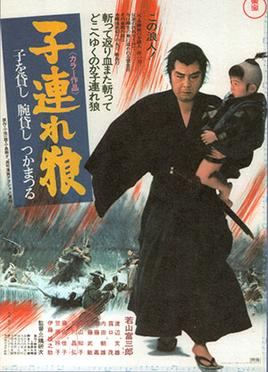
Lone Wolf and Cub: Sword of Vengeance is a 1972 Japanese chambara film directed by Kenji Misumi. The film tells the story of Ogami Ittō, a wandering assassin for hire who is accompanied by his young son, Daigoro. It is the first in a series of six films in the Lone Wolf and Cub series.

Lone Wolf and Cub: Baby Cart at the River Styx is the second in a series of six Japanese martial arts films based on the long-running Lone Wolf and Cub manga series about Ogami Ittō, a wandering assassin for hire who is accompanied by his young son, Daigoro.
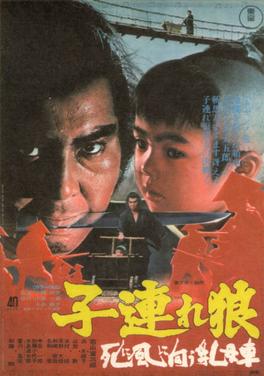
Lone Wolf and Cub: Baby Cart to Hades, is the third in a series of six Japanese martial arts films based on the long-running Lone Wolf and Cub manga series about Ogami Ittō, a wandering assassin for hire who is accompanied by his young son, Daigoro.
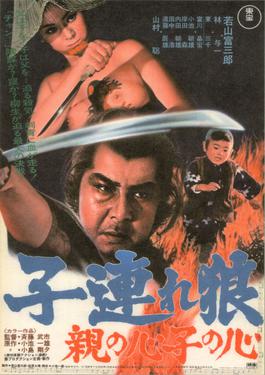
Lone Wolf and Cub: Baby Cart in Peril is the fourth in a series of six Japanese martial arts films based on the long-running Lone Wolf and Cub manga series about Ogami Ittō, directed by Buichi Saitō.

Lone Wolf and Cub: Baby Cart in the Land of Demons is the fifth in a series of six Japanese martial arts films based on the long-running Lone Wolf and Cub manga series about Ogami Ittō, a wandering assassin for hire who is accompanied by his young son, Daigoro.
Lone Wolf and Cub: White Heaven in Hell is the final entry in a series of six Japanese martial arts films based on the long-running Lone Wolf and Cub manga series about Ogami Ittō, a wandering assassin for hire who is accompanied by his young son, Daigoro. Although this is the last film in the series, it does not end the story or include the conclusion of the series as written in the manga.

Yorozuya Kinnosuke (萬屋錦之介) was a Japanese kabuki actor. Born Kin'ichi Ogawa, son of kabuki actor Nakamura Tokizō III, he entered kabuki and became the first in the kabuki tradition to take the name Nakamura Kinnosuke. He took on his guild name (yagō) Yorozuya as his surname in 1971.

Fumio Watanabe was a Japanese actor most known for his work with Japanese New Wave director Nagisa Oshima. He was born in Tokyo and graduated from the University of Tokyo before joining the Shōchiku studio in 1956.
Kawaite sōrō (乾いて候) is a Japanese jidaigeki or period drama that was broadcast in prime-time in 1984. It is also known as "A Samurai's Sorrow." It is based on Goseki Kojima and Kazuo Koike's manga of the same title. The lead star is Masakazu Tamura. Masakazu Tamura's elder brother Takahiro Tamura and younger brother Ryo Tamura also appeared. Three special editions of the drama were produced. Masakazu Tamura played the role on stage.
Akira Inoue was a Japanese film director.
Minoru Ōki was a Japanese actor. His notable film appearances were Lone Wolf and Cub films, Stakeout, and Not Forgotten.

New Lone Wolf and Cub is a Japanese manga series written by Kazuo Koike and illustrated by Hideki Mori. It is a sequel to Koike's manga series Lone Wolf and Cub. It was serialized in Shogakukan's Weekly Post from November 2003 to December 2006, with its chapters collected in 11 tankōbon volumes. It was licensed in North America by Dark Horse Comics. A sequel series, titled Soshite Kozure Ōkami: Shikaku no Ko, was published in Koike Shoin's Jin (2007–2008) and eBookJapan's digital manga magazine Katana (2009–2010), with its chapters collected in five volumes.
References
- ↑ "その小さき手に". 映画db. Retrieved 24 December 2020.
- ↑ "井上昭". 日本映画監督. Retrieved 24 December 2020.
- 1 2 "Lone Wolf and Cub: Final Conflict". kotobank. Retrieved 24 December 2020.
- ↑ "Lone Wolf and Cub: Final Conflict". Kinema Junpo . Retrieved 11 January 2021.
- ↑ "その小さき手に". allcinema. Retrieved 10 August 2017.
- ↑ "田村正和 追悼:テレビ界の大スターとしての栄光の奥に秘められた映画俳優としての素養" (in Japanese). シネマプラス. Retrieved 11 December 2021.
- ↑ "Kozure Ōkami: Sono chiisaki te ni". 一般社団法人 日本映画製作者連盟. Retrieved 10 August 2017.
- ↑ "田村正和祭り」美剣士・腕下主丞の「乾いて候」から「子連れ狼」まで!マネのできない正和的世界". 時代劇専門チャンネル. Retrieved 24 October 2018.
- 1 2 3 "Kozure Ōkami: Sono chiisaki te ni". Agency for Cultural Affairs 日本映画情報システム. Retrieved 23 November 2018.
- ↑ 子連れ狼 その小さき手に Official pamphlet P.4
- ↑ "「子連れ狼」なぜハリウッドでリメイク? 血みどろの殺陣シーンでカルト的人気". バズフィード. Retrieved 24 December 2020.
- ↑ "子連れ狼 その小さき手に". 松竹. Retrieved 24 December 2020.
- ↑ "田村正和x香取信吾". テレビ朝日 smastation. Retrieved 24 December 2020.
- ↑ "時代劇『子連れ狼』がハリウッドで映画化! 『ワイルド・スピード』の人気アクション監督がメガホン". gqjapan. 2 April 2012. Retrieved 24 December 2020.
- ↑ 第 17 回日本アカデミー賞優秀作品 (in Japanese). Japan Academy Prize. Retrieved 16 December 2020.